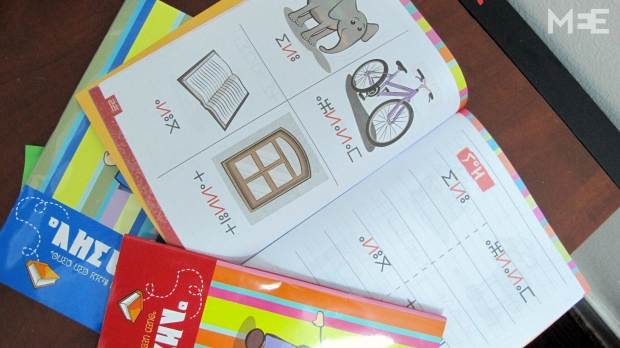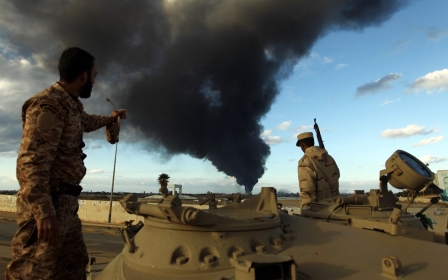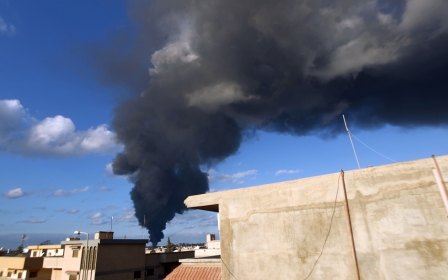The Amazigh of Libya revive their previously banned language
JADU, Libya - The children wear woollen hats to stay warm inside their classroom in the Nafusa mountain range southwest of Tripoli, while they study a virtually unknown alphabet.
"We are currently offering three hours a week of Amazigh language, (Tamazight), between the first and fourth grades of primary education," said Said Azabi, the school manager in Mezzo, a district of Jadu, a town of 6,000 in the Amazigh enclave.
Also called Berbers, the Amazigh are native inhabitants of North Africa, with a population extending from Morocco’s Atlantic coast to the west bank of the Nile in Egypt. The Touareg tribes in the interior of the Sahara desert share the same ancient tongue.
However, the arrival of the Arabs in the region in the seventh century was the beginning of a slow yet gradual process of Arabisation. Today, unofficial estimates put the number of Amazighs in Libya up to almost 600,000, about 10 percent of the total population.
"The first lessons in Tamazight, the Amazigh language, started in makeshift schools here, in the mountains, when the war was not even over," said Azabi during recess, referring to the 2011 civil war that brought down Muammar Gaddafi. The school books and the teachers are “the result of the selfless work of a legion of volunteers”.
In 1973, Gaddafi launched a “Cultural Revolution” under which any publications not in accordance with the principles espoused in his “Green Book” were destroyed. That included those mentioning the Amazigh. According to Gaddafi, the Amazigh were of “Arab origin” and their language “a mere dialect”. Registration of non-Arab names was forbidden, Libya's first Amazigh organisation was banned and anyone involved in their cultural revival prosecuted.
Alongside his twin brother, language activist Madghis Buzakhar was put in jail after a book collection they had gathered was confiscated by the former regime's security forces. Today, Buzakhar is part of the group releasing the language books used in schools like the one in Jadu. The 33-year-old points to a “massive joint effort”.
“We literally started from scratch, and now we are all struggling to recover the time we painfully lost,” Buzakhar said from the headquarters of the organisation he co-founded in 2011 with his brother, Tira Research and Studies, in central Tripoli.
Down the valley
Although based in Tripoli, the Buzakhars are native of the Nafusa mountains. Climbing to more than 2,500 feet (750 metres) above sea level, the mountain ranges are doubtless the community's main stronghold in Libya but not the only one where their ancient language has survived.
A second important enclave for the Libyan Amazigh is in the coastal town of Zuwara, about 60km from the Tunisian border. Much of the cultural activity here takes place in a compound that hosts the local radio station. Today, around 15 volunteer teachers are attending a workshop on the new language materials for fourth and fifth grades.
"The majority of us have Tamazight as our mother tongue, but it wasn't until 2011 that we started to use our own alphabet too. We call it Tifinagh, and it was forbidden during Gaddafi's time,” said Noha Alasi, a 24-year-old architect who volunteers in the language program. “The only way to learn how to read and write during Gaddafi was through the Internet. That's how we all taught it to ourselves.”
"Today we have 60 teachers working in 26 schools in Zuwara, but it is far from being enough," said the 33-year-old volunteer, who is in charge of evaluating new teachers. Halib said there is “a lack of both a qualified staff and an overall plan to improve education levels in the long term”.
According to UNICEF, around 33 percent of schools were damaged and 24 percent were used for military or humanitarian purposes during the conflict in 2011. UNICEF also says that about 20,000 of the estimated 70,000 people internally displaced by the conflict are children, “many of whom are not attending school”.
For Najib Sasi, an arts teacher and head of the office of Tamazight teaching at the Libyan Ministry of Education, there are other hurdles beyond those dealing with plain logistics.
"On the one hand, we have to deal with a mindset that is deeply rooted in Arabism, and we cannot forget the growing political turmoil in the country. By the time we manage to get started with one government, this one changes and we're back to square one," Sasi said from his desk in Zuwara.
Three years after Gaddafi was toppled and killed, Libya remains in a state of chaos that has put the country on the brink of civil war. There are two governments and two separate parliaments - one based in Tripoli and the other in Tobruk, about 600 miles (1,000km) east of the capital. The latter, set up after elections in June when only 10 percent of the census population took part, and which was largely boycotted by the Amazigh community, has international recognition.
Accordingly, Libya is an open battlefield where several militias fight grouped into two paramilitary alliances: Fajr (“Dawn” in Arabic), led by the Misrata brigades controlling Tripoli, and Karama (“Dignity”), commanded by Khalifa Haftar, a Tobruk-based former army general. Haftar has conducted several air strikes against Zwara over the the past few weeks.
A shared experience
"How can we possibly work in these conditions?" said Hafed Fatis from the battered coastal town. At 48, Fatis was selected in 2013 to attend a three-month course in the Spanish Basque country at the invitation of Garabide, an NGO that shares its experience in the normalisation of the Basque language with members of other minority languages.
"We were 14 in total in a group that included Kurds, Aymaras, Quechuas... That workshop was very much an eye-opener for me," said Fatis, today striving to turn what he learned into tools that can bring tangible results in his native Zwara. That will take time.
"Many here want immediate results, but one thing I learned from the Basques is that the normalization of a long-neglected language is a project for the long term," said Fatis.
Children attending the third grade in Jadu will grow up to see the fruits of such efforts with Tamazight. However, they are all too young to keep any memories of the times when the language they are now studying at school could only be spoken inside their homes.
A few among the 20 in the class in Mezzo did not even live in Libya before 2011. One of whom is Talia. Both of her parents arrived from Sudan soon after the war. Even so, the nine-year-old is almost as fluent in Tamazight as the rest of her classmates. The reason may look only too obvious:
"My house is here, in Jadu. I'm Libyan," says the girl, shortly before the end of the class.
--
A sample of Tamazight can be heard being taught here in this youvideo by Libya Al Ahrar TV from 13 July 2011 from You Tube:
Middle East Eye propose une couverture et une analyse indépendantes et incomparables du Moyen-Orient, de l’Afrique du Nord et d’autres régions du monde. Pour en savoir plus sur la reprise de ce contenu et les frais qui s’appliquent, veuillez remplir ce formulaire [en anglais]. Pour en savoir plus sur MEE, cliquez ici [en anglais].






